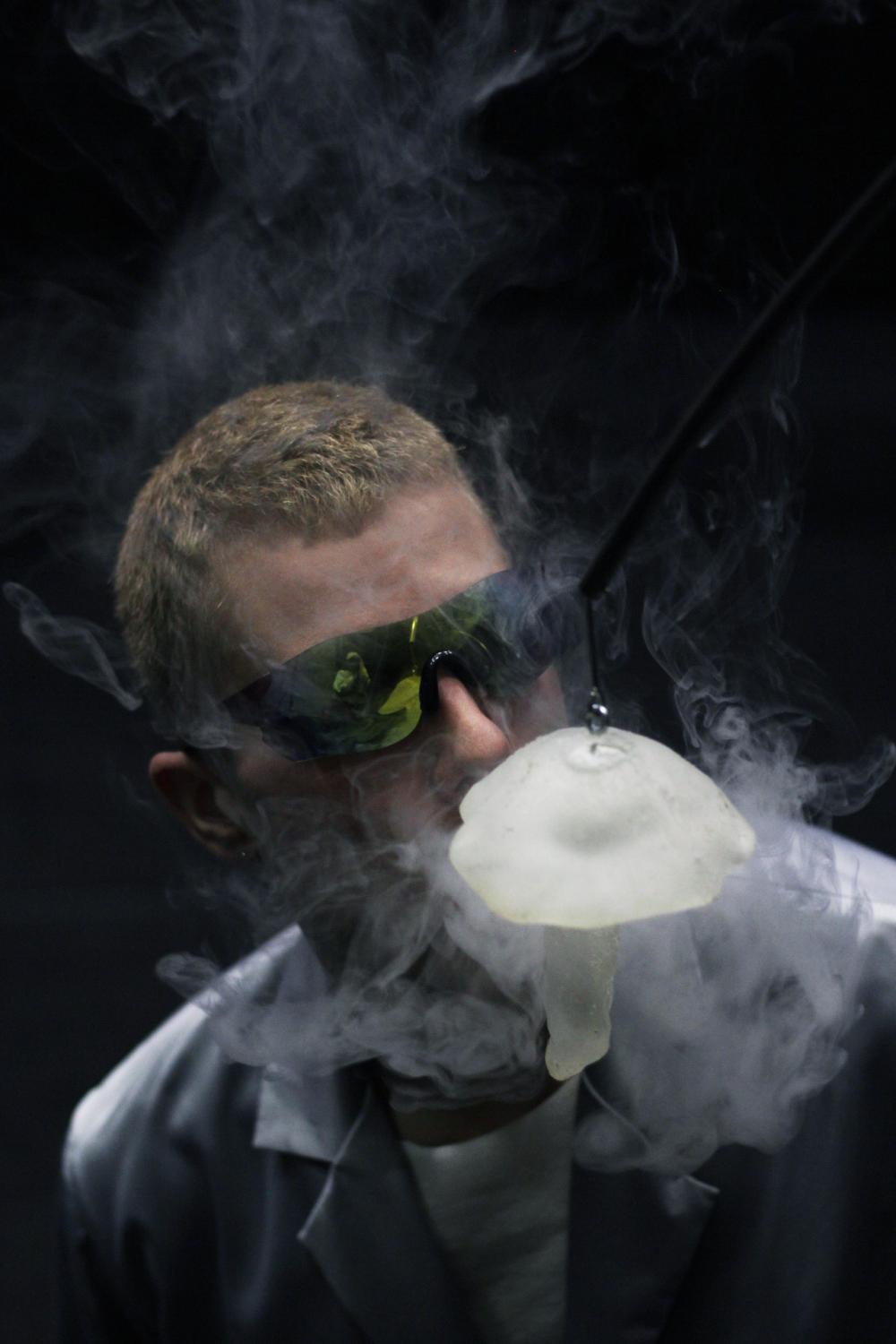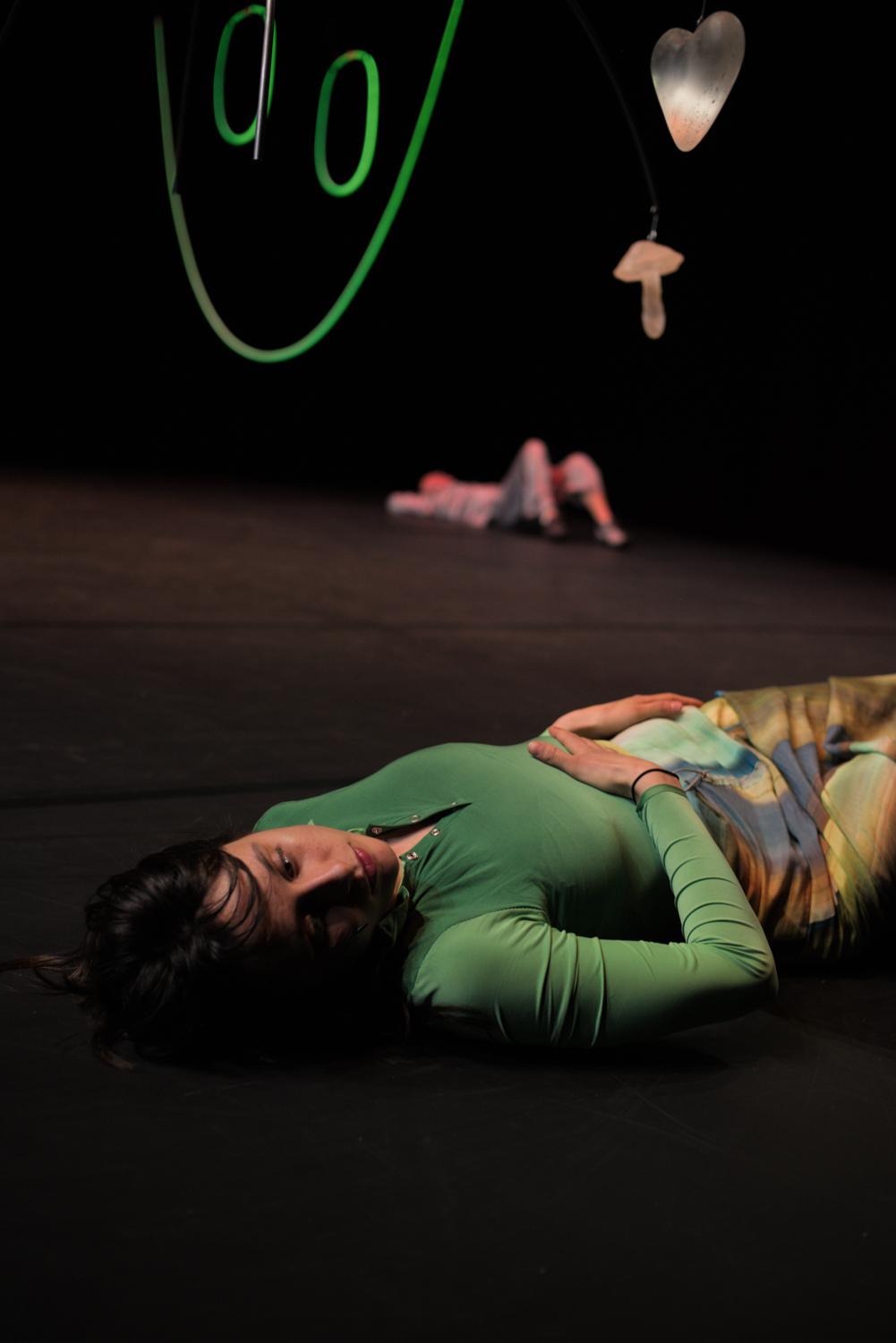Ambient Fury Theatre
Here you find a short description of the performance and the credits.
I think we make theatre to look at the world, outside of ourselves
Interview by Dlisah Lapidus (Subbacultcha, March 2022)
Theatremaking and performing duo Anna Franziska Jäger and Nathan Ooms have worked together to dissect subjectivity, communication and relationships on stage for six years. Now, they are preparing their latest theatrical conversation: Ambient Theater Fury, which will show at Campo on 30, 31 March and 1 April. Ambient Theater Fury will discuss the ambience saturating the online world, our general loss of communication, and the possibilities for resolution. We sat down with Anna Franziska and Nathan to discuss The Death Of Dialogue And How To Avoid It.
When did you two begin working together, and at Campo?
Nathan: We started working together in our first year of theatre school, six years ago. We started with some small projects and continued to work together.
Anna Franziska: Working here at Campo is a really great experience. During school, they offer studio spaces for students, and they came to see our shows, and we began to engage in conversation.
N: It is nice to have a place where we get the time and the money to work in the way we want to work. It feels like a luxury, having only graduated so recently, to have that kind of support, allowing us to focus on the work.
What is your process in working together?
N: It is usually very messy, so it's hard to trace it back exactly because we are often a bit lost ourselves. In general, we try to navigate between going on the floor and trying things physically and being behind the laptop, writing. There is this back and forth. And we spend a lot of time looking at things online…
A: Collecting materials that we found in different ‘corners’ of the internet. We’re interested in how we express ourselves online, how our subjectivities are formed, how we perceive ourselves when it is so strongly digitally mediated. What kind of forms do we use to do so and what happens when we play with these forms in a theatre context, on stage.
N: The process of collecting is not random, but it's also not always with a very clear purpose, I think it is quite intuitive. We think 'Ah there is something there,' before knowing what it is exactly that attracts us in a video or text we find. We collect and then spend time with our findings. We do this over and over again, trying to combine things in different ways, into a kind of collage, trying to create a text that makes sense. For this piece, we started from writing and editing text, although in an early phase we were already exploring more physical aspects. Slowly, the two braid more and more together.
Tell me about your performance, Ambient Theater Fury.
N: Ambient Theater Fury is a duet in which we work with dialogue as a form but also as a topic and theme. The subtitle of the piece is The death of dialogue and how to avoid it. This performance explores our highly digitalized world, in which there is a lot of exchange of information, a lot of connection, but maybe a little real conversation, or dialogue that allows for opposition and friction.
N: We want to create characters that struggle with different types of self-consciousness and self-awareness that inhibits them from actually seeing and hearing each other. In the second part of the piece, we work with very short fragments of hyper-confrontational dialogue, where the characters are constantly on top of each other. But both parts witness this kind of impossibility for communication.
Is it how to avoid the Death of Dialogue, or Dialogue itself?
N: That is the double meaning of course, but we are hoping to get to the point where we can discuss how to avoid its death. This potentially happens in a third part of the piece.
A: But we always tend to go after the extremes first, exaggerating it to the point that there is nothing left to say or do.
N: We hope to arrive at a point where the characters can create something new out of themselves, outside of the equation of their being together, how can they, through conversation, create a third image.
These days, we are communicating in such different ways than we used to, on platforms that didn't exist or were not nearly as popular. Has this had an impact on the way you now view communication and dialogue in this work?
N: We have worked around topics of communication for a while now, but the way that it has evolved, through the episodes of isolation we went through, this idea seems to have become more sensible, more experienced on a daily basis.
A: It is a new reality. I think in a way the Ambience that we try to evoke in the piece is important because of this isolation. We were alone, enclosed in private spaces or small bubbles in which you engage in online immersive experiences. Not necessarily for escapism, but something like Netflix, or ASMR content on youtube numbs the mind, becoming a kind of equalizing experience that can go on and on in attempts to soothe the hyperactive mind. Or playing a Billie Eilish song on repeat for 10 hours, placing you somewhere between being awake and asleep. This insomniac state is more generalized for a lot of people now. In the second part of the text that we are working on, there is a lot of looping, representing this uncanny point where you lose sight of the beginning and the end, you get lost in that.
Tell me more about your collecting process.
N: We are often attracted to materials that at the same time disgust us. And that's often a difficult position to create work from. On one hand, this double position makes it possible to understand, rearticulate and reformulate what we find in these materials. But at the same time, it is often challenging because there are often texts that carry within them a certain existential ennui, or an emptiness. Especially for this piece, this ambient component, this content that just streams over you, erasing your subjectivity, and numbs your experience of time. We are interested in appropriating this, but at some points, it is necessary to insist on taking distance in order to be able to do something with it.
A: Because while doing so you almost become the material, which can easily inflate one’s self-consciousness. You can really become obsessed if you focus so much on the interior world. When we bring into question what the interior world is today, or if it even still exists, after a while we can get stuck in those narcissistic modes ourselves. But I think we make theatre to look at the world, outside of ourselves.
N: But this outside is also this narcissistic, self-obsessed, hyper self-aware, disturbed kind of subjectivity.
How are you incorporating this idea of Ambience, which you seem critical of, into the theatre setting?
N: We are interested in this ambient content and experiences, but we do not wish to reproduce them. We are critical of them, we think they do not lead us where we want to go.
By showing characters that are subjugated to this, rather than subjugating the audience to it. We can show where the characters have ended up after years of hibernation listening to Billie Eilish on repeat.
A: Online, we all engage with a lot of material in which we want to lose attention and lose our minds, forget about daily life, but at the same time we have modes of deep attention and deep focus. I think the theatre setting engages the audience in these modes of attention and has a way of capturing the public. In the situation of a black box, it is very dominant.
N: It is also a quite unique situation in that you can create an experience for someone. There is no scrolling past or clicking away. And if you really want to leave, you have to kind of make a statement, because it goes against the codes of attending theatre.
This was definitely something we thought and wrote about during the lockdown when no one could go to see theatre, there were all these online alternatives, and we really experienced how contradictory this is to what theatre is really about, or what it is for us. Theatre is about being stuck in a room with an audience. The audience can’t mute the performance as one can with a streamed performance, but of course, they can still zone out, or slip away in your mind, so it is still the responsibility of the performer to capture the audience.
How do you attempt to capture the audience?
N: We often work with kind of repulsive characters, so then the question becomes, how can you maintain a certain degree of empathy in order for the audience to want to be close to them?
A: I think that's the nice thing about art, that you can empathise with characters you may find morally appalling.
Is this more difficult to achieve in a digital age?
A: It is now very difficult to separate the digital and physical worlds, who we are online and offline. We also suffered a radical loss of attention. We sometimes talk about Post-internet brains, the feeling that something turned mushy. Theatre is also a medium, it would be dangerous to claim that theatre is authentic just because you have flesh and blood bodies, because really it is a messy place, because theatre has always had a connection to the virtual, or what is not physically present.
N: But what's nice is that in theatre the audience is very real, they are there. On digital platforms and social media, there is also an audience and you kind of know they're there, but it's more abstract. At least in the theatre, there is a limitation to who is actually there, which allows for a different kind of interaction.

